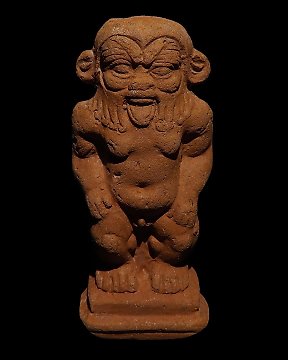
Antiguo Egipto Terracota Dios Bes. 9 cm H. 30 aC – 1 dC.
N.º 84870751

N.º 84870751

Head of a sculpture of the god Serapis.
- very fine surface -
Ancient Egypt, Ptolemaic-Roman period, 332 BC. - 1st century AD.
Schist.
9.5 cm height, 14 with the stand.
Condition: Good general state of preservation, with wear on the nose.
Provenance: Private collection Paris, France, 1960 - 1970.
Description:
The Cult of Serapis was promoted by Ptolemy I Sotar (Ptolemaic dynasty) as a means of fostering harmony between his Egyptian and Greek subjects. The god combined Osiris and the Apis Bull (the sacred bull of Memphis) with aspects of the Greek gods Zeus (the king of the gods), Dionysus (also known as Bacchus, the god of wine), Helios (the personification of the Sun), Hades (the god of the underworld) and Asklepios (god of medicine).
Linguistically, his name is the result of the fusion of Osiris and Apis, and there is evidence that a cult of Osarapis existed before the Ptolemaic Period, but the Ptolemaic version was a more Greek conception.
Serapis personified divine majesty and represented the sun, fertility, healing, and the afterlife. His consort was Isis, the wife of Osiris and the most popular goddess during the Ptolemaic Period.
Serapis was depicted as a man with an elaborate Greek hairstyle wearing Greek style robes and a full beard. He often wears a corn modius or sheaf on his head. Less often, he is depicted as a serpent in recognition of his connection with the underworld and fertility.
Ptolemy built the Serapeum in Alexandria as the cult center of the new god and it remained the focus of pilgrimage until it was destroyed by the Emperor Theodosius in AD 389. Other smaller shrines and temples were constructed or adapted throughout Egypt, and the cult even spread to Roman territories.
The Serapeum in Saqqara (the home of the Apis bull) grew in popularity with the Greeks thanks to the connection with Serapis, but the native Egyptians never really took to this Hellenized version of Osiris.
Notes:
- The piece includes authenticity certificate.
- The piece includes Spanish Export License (Passport for European Union) - If the piece is destined outside the European Union a substitution of the export permit should be requested, can take between 1-2 weeks maximum.
- The seller guarantees that he acquired this piece according to all national and international laws related to the ownership of cultural property. Provenance statement seen by Catawiki.
Cómo comprar en Catawiki
1. Descubre algo especial
2. Haz la puja más alta
3. Paga de manera segura